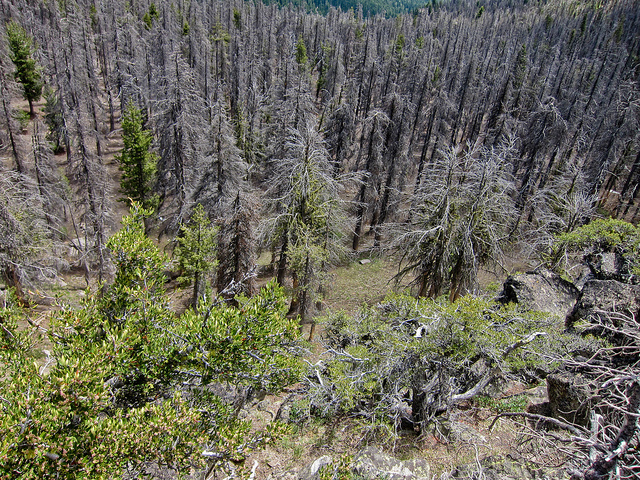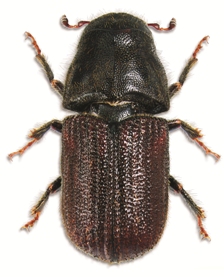How can you deny what’s in front of your eyes?

[CC photo credit: Michael McCullough (ex_magician) | Flickr]
 In the mid-1990s, an outbreak of pine mountain beetle infestation began in the western United States up through Canada and has decimated a truly phenomenal number of forests. In Colorado this year, an estimated quarter million acres of forest are affected, down from over a million acres in 2008, mainly because most of the most vulnerable trees have already died. According to a piece in Science magazine, about 13 million hectares (32+ million acres) have been decimated since this most recent infestation began. That’s forest land roughly the size of the entire state of Alabama. The NRDC reports that “70% of the whitebark pine trees in and around the Greater Yellowstone Ecosystem” have died from the infestation.
In the mid-1990s, an outbreak of pine mountain beetle infestation began in the western United States up through Canada and has decimated a truly phenomenal number of forests. In Colorado this year, an estimated quarter million acres of forest are affected, down from over a million acres in 2008, mainly because most of the most vulnerable trees have already died. According to a piece in Science magazine, about 13 million hectares (32+ million acres) have been decimated since this most recent infestation began. That’s forest land roughly the size of the entire state of Alabama. The NRDC reports that “70% of the whitebark pine trees in and around the Greater Yellowstone Ecosystem” have died from the infestation.
These insects are rather incredible in terms of the speed with which they can kill a tree:
Mountain pine beetles affect pine trees by laying eggs under the bark. The beetles introduce blue stain fungus into the sapwood that prevents the tree from repelling and killing the attacking beetles with tree pitch flow. The fungus also blocks water and nutrient transport within the tree. On the tree exterior, this results in popcorn-shaped masses of resin, called “pitch tubes”, where the beetles have entered. The joint action of larval feeding and fungal colonization kills the host tree within a few weeks of successful attack.
Scientists are now seeing the beetles hatching two generations of beetles per year due to the extended summers created by climate change. As University of Colorado professor Jeffry Mitton explains, that’s not a doubling of beetles, that’s an exponential growth:
The evolution of mountain pine beetles to produce two generations of beetle per year instead of one has probably been a factor in the unparalleled damage that insects have caused in pine forests in the western United States and Canada over the last decade, according to a new study.The findings, published online in The American Naturalist, may explain in part how the scale of beetle-killed forest in the West became so vast. The number of acres killed in the last decade or so is 10 times that of any previous epidemic recorded, and it’s not over. The damage stretches from California across the prairies to the east, and from New Mexico to northern Canada.
Jeffry B. Mitton, a professor of ecology at the University of Colorado at Boulder and the lead author of the study, and a graduate student, Scott Ferrenberg, watched the bugs attack 15 pine trees in the southern Rockies in Colorado in the first week of June, about six weeks earlier than normal. Then the bugs laid eggs that hatched, and the new beetles flew to other trees in early August, the time of year when the species would normally attack a tree.
Two generations of beetles in one summer greatly increases the army that attacks trees. “It’s not twice as many beetles, it’s an exponential increase,” Dr. Mitton said. Each beetle lays 60 eggs and, since nearly all survive, each of those beetles goes on to lay 60 eggs in the same summer, which means 3,600 more beetles.
Several years ago, scientists reported in Nature magazine that the destruction of forests by the pine mountain beetle is creating a frightening climate change feedback loop. The article, “Mountain pine beetle and forest carbon feedback to climate change” (you can read the entire article HERE [pdf]), explains it this way:
During outbreaks, the resulting widespread tree mortality reduces forest carbon uptake and increases future emissions from the decay of killed trees. The impacts of insects on forest carbon dynamics, however, are generally ignored in large-scale modelling analyses. The current outbreak in British Columbia, Canada, is an order of magnitude larger in area and severity than all previous recorded outbreaks. Here we estimate that the cumulative impact of the beetle outbreak in the affected region during 2000–2020 will be 270 megatonnes (Mt) carbon (or 36 g carbon m-2 yr-1 on average over 374,000 km2 of forest). This impact converted the forest from a small net carbon sink to a large net carbon source both during and immediately after the outbreak. In the worst year, the impacts resulting from the beetle outbreak in British Columbia were equivalent to ~75% of the average annual direct forest fire emissions from all of Canada during 1959–1999. The resulting reduction in net primary production was of similar magnitude to increases observed during the 1980s and 1990s as a result of global change. Climate change has contributed to the unprecedented extent and severity of this outbreak. Insect outbreaks such as this represent an important mechanism by which climate change may undermine the ability of northern forests to take up and store atmospheric carbon, and such impacts should be accounted for in large-scale modelling analyses.
The TL;DR version of this is that climate change has accelerated the spread of the beetles and now the beetles are speeding up climate change by converting forested regions from carbon sinks to carbon producers as killed trees decay and burn up in forest fires.
This incredible devastation of North American forests by the pine mountain beetle is, of course, not without its economic impacts. Last month, two companies, Canfor and West Fraser, announced that they are closing sawmills due to a lack of trees to process. And that’s on top of many others that have already closed with more to come:
The recent announcement by Canfor and West Fraser that there were both closing sawmills in the B.C. Interior seems to have caught many in the industry by surprise. While the timing of the announcement was slightly sooner than previously forecast, these closures should be of no surprise to subscribers of WOOD MARKETS’ reports on MPB in B.C. Interior.These two specific sawmill closure announcements are the most recent in a long list of predicted mill closures in the wake of the mountain pine beetle (MPB) epidemic which exploded starting in the late 1990s in the B.C. Interior… [T]here are more mill closures to come – as was originally forecast.
On March 17, 2010, one key outlook was tabled (and created some controversy at the time): “Sawlog shortages caused by the mountain pine beetle could trigger the permanent closure of about 16 large primary sawmills and/or plywood production facilities within the B.C. Interior by 2018 (with more to follow).”
This forecast was predicated on a reduction in the sawlog supply that would occur as the economics of milling dead timber fell in response to the MPB epidemic. The loss of economic sawlogs was forecast to eliminate about 20% of the B.C. Interior sawlog supply. It was also assumed that remaining sawmills would have to operate at less than capacity in order to balance the remaining mid-term sawlog supply with sawmill demand.
Following the Canfor and West Fraser sawmill closure announcements, there are now 12 sawmills that have closed since our March 2010 prediction of 16 sawmill closures. And we see additional sawmills closing, especially in Cariboo region (Quesnel, William Lakes, and 100 Mile House) of the province where a sawlog shortage is becoming most acute.
It goes without saying that these mill closures are only part of the economic impact in the areas affected by the destruction inflicted by this tiny insect over the past two decades.
In other words, we don’t need to rely on scientists’ forecasts about how global climate change will affect our economic climate. Those impacts have already begun.
And no amount of head-in-the-sand denialism will change what is right in front of our eyes.
[CC pine mountain beetle photo credit: Eztempt | Wikimedia Commons]



